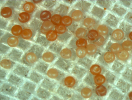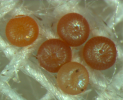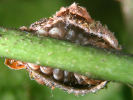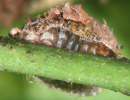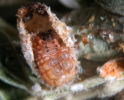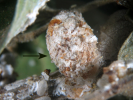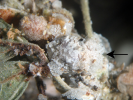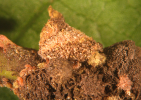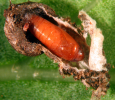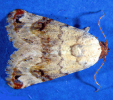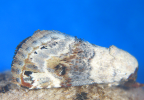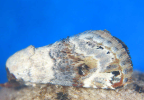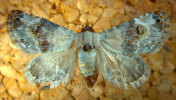 |
Scientific nameCoccidiphaga scitula (Rambur) (=Eublemma scitula (Rambur))
Taxonomic positionLepidoptera: Noctuidae: Acontiinae
DescriptionThe larvae of this species are bright pink to reddish, with the posterior half of the body much enlarged, with a pair of large suckers for adhering to the substrate (modified prolegs). The larval body is always covered with a light silken web to which debris and the host remains become attached, and this serves as a shield which is carried about as the larvae move from place to place. Pupation takes place within the shield-like structure, which is fastened to the leaf or twig surface.
ImagesDistributionIndia and several other parts of the world.
Hosts / Associated habitatEublemma scitula has been recorded as a predator of scales from different parts of the world (Clausen, 1940). Within the Noctuidae, the entire genus Eublemma is carnivorous on scale insects, except for Eublemma radda Swinhoe, a species that feeds on insects trapped by pitcher plants. In India, Eublemma amabilis Moore feeds only on Kerria, whereas Eublemma
scitula Rambur feeds on a wider range of scales comprising Kerria, Anomalococcus, Lecanium, Ceroplastes, and Pulvinaria (Pierce, 1995). Pierce (1995) listed noctuids, including
Eublemma spp., recorded as predators on Homoptera. The photographs featured here were taken in association with Drepanococcus cajani (=Ceroplastodes cajani) (Coccidae), Cerococcus indicus (Maskell) (Cerococcidae) and Coccidohystrix insolita (Green) (Pseudococcidae) on pigeon pea.
Pathak & Yadav (2000) studied its biology on Saissetia coffeae. Eggs of the predator were laid singly and hatched in 4-6 days. All the larval stages were predatory on scale insect and consumed on an average 18.05 mature female scales, the maximum being 22 during the larval period (Pathak & Yadav, 2000). As many as six generations are annually recorded in India (Clausen, 1940). References
|
